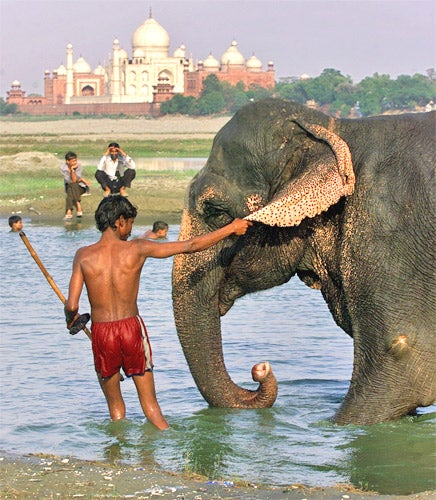India's elephants finally given same protection as tigers

The humble hardworking elephant is not an animal that usually likes to complain. But over the years, while higher-profile, more urgently threatened species have been the subject of widescale conservation efforts, elephant numbers have been allowed to dwindle. Perhaps worse, the gender ratio – since only males have tusks, it is they who are sought by poachers – has become perilously skewed.
In an attempt to address these concerns, the Indian authorities have now decided to declare the elephant its "national heritage animal" and to afford it the same level of protection as bestowed upon the mighty tiger. "We need to give the same degree of importance to the elephant as is given to the tiger in order to protect the big animal," said the Environment minister, Jairam Ramesh.
It is estimated there are 26,000 Asian elephants in India today, of which 3,500 are working animals. While the total population has not experienced the sort of drastic decline undergone by the tiger, the gender ratio is skewed so that in some areas there is just one male elephant for 100 females. At the same time, the habitats of the large animals are constantly being diminished by the expansion of human communities. As a result of such conflict, some 400 people are trampled to death every year in India by wild elephants and dozens of elephants are killed by villagers in retaliation.
"Elephant habitats are under tremendous pressure. Rapid economic expansion and development pressures require far more attention than land use plans from an ecological perspective," a panel, commissioned by the government, announced this week. "New knowledge needs to be brought in regarding the population and habitat assessment."
The panel, tasked with studying the elephant problem and finding solutions, suggested a series of measures to help retain the elephant population and minimise conflicts between the animals and people. Among the proposals was the establishment of a national elephant conservation authority, better management of elephant reserves and protection of almost 90 corridors that the animals use across the country from mining, irrigation and other industrial projects.
It also called for educating the authorities at Hindu temples in the south of the country about the proper treatment and care of "temple elephants" and suggested that forest guards tasked with protecting the animals required better training and more modern equipment. Staff at such parks are notoriously badly paid, giving them little incentive to perform well.
The chairman of the 12-member panel, Mahesh Rangarajan, a professor of history at Delhi University, told The Independent that whereas in the 1960s and 1970s the Indian government had thrown itself behind tiger conservation, the plight of elephants had been largely overlooked.
"The tiger captured the political imagination and came to symbolise India's threatened wildlife, but the elephant did not," he said. "I think the threat to the tiger invoked a sense of crisis and then everybody rallied around." He added: "With the elephant it is not a crisis of extinction, but a crisis of attrition."
India's tigers face a much more pressing threat. From an estimated total of 100,000 in 1900, the population is now officially listed at a little over 1,400. Yet many experts believe the true size of the community may be half of that.
While tigers are threatened by human incursion into their habitat and depletion of prey species, the main reason for their tumultuous decline has been the failure to stop the illegal trade for tiger parts for traditional Chinese medicine.
Join our commenting forum
Join thought-provoking conversations, follow other Independent readers and see their replies
0Comments